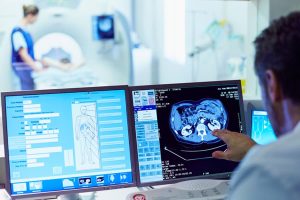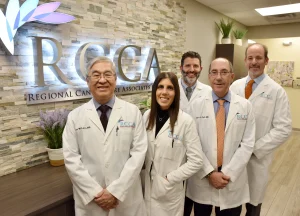
PSMA Therapy for Metastatic Prostate Cancer
A targeted, infused therapy that delivers radiation directly to cancerous cells has been shown to extend survival in many patients with metastatic prostate cancer. The
HIPAA Alert: Potential Data Breach Learn More
Questions on Oncology, Hematology and/or Infusion Clinical Services due to COVID-19 Crisis – CALL 833-698-1623
Important Information for Our Patients Regarding the Coronavirus.
RCCA Providing Area Cancer Patients with Access to Care During Coronavirus Outbreak
RCCA Offering Patients Virtual Visits During Coronavirus Pandemic
Being diagnosed with breast cancer will always be challenging, but patients can find hope in increasing survival rates. According to the American Cancer Society, the five-year relative survival rate for localized breast cancer—when cancer has not spread outside the breast—is 99 percent. Advances in treatment and a greater emphasis on early detection have resulted in higher survival rates than patients experienced even just a few decades ago. Discover more about breast cancer survival rates and preventive care from the oncology team at Regional Cancer Care Associates (RCCA).

The five-year relative survival rate compares survival in patients with a specific type and stage of cancer to survival in individuals in the overall population. So, a 99 percent survival rate means that people diagnosed with localized breast cancer are about 99 percent as likely to live for at least five years following their diagnosis as those without breast cancer.
The 99 percent survival rate is even more impressive when viewed in the context of recent history. A study from the National Institutes of Health (NIH) looked at five-year survival rates for localized, regional, and metastatic breast cancer among women in the United States aged 20 to 39 from 1975 to 2015.
The study’s findings are compelling. Between 1975 and 1979, the five-year relative survival rate for localized breast cancer was 85 percent. Between 2010 and 2015, this percentage rose to 94.8 percent. The current 99 percent survival rate indicates a continuation of this positive trend.
Survival rates have increased for other breast cancer stages, as well. Stage II and stage III breast cancer signify regional disease, meaning the cancer has spread outside the breast to neighboring lymph nodes and structures.
The NIH study records the combined five-year relative survival rate for those stages as 62.8 percent between 1975 and 1979 and 85.2 percent between 2010 and 2015. Today, the five-year relative survival rate for patients with regional breast cancer is about 86 percent.
Patients should note that the five-year relative survival rate does not account for several factors that may impact a patient’s outcome, such as age or the tumor grade. Also, it applies only to the stage of cancer at diagnosis. The patient’s prognosis – meaning her likely outcome – changes if the cancer spreads or comes back after a period of remission. Still, survival rates are on the rise, giving patients more hope against one of the most common cancers.
Advanced treatment options are one of the main reasons for better outcomes in patients with many conditions and diseases, and breast cancer is no exception. The key to better outcomes is providing personalized breast cancer treatment, with the choice of therapy (or, often, therapies) based on multiple factors, such as the patient’s age, general health, presence of any genetic mutations (such as BRCA1 and BRCA2), and the stage of the cancer.
Research into breast cancer has enabled doctors to distinguish between different types of cancer and tailor treatment plans accordingly. Some breast cancers are hormone receptor (HR) positive, which means cancer cells contain estrogen and/or progesterone receptors on their surface.
Other people have HER-2-positive breast cancer. The HER-2 proteins are receptors on breast cells, regulating the growth and function of those cells. In a patient with HER-2-positive breast cancer, the HER-2 gene copies itself too many times, causing uncontrolled breast cell growth.
Doctors consider all of these factors and more when determining which treatment options to recommend to their patients with breast cancer. The following are some of the most effective breast cancer treatments:
Surgery is a common treatment for breast cancer. Advances in technology have enabled minimally invasive approaches that may reduce recovery times and the need for hospital stays, while in many cases preserving healthy beast tissue.
Types of breast cancer surgery include:
With chemotherapy, the patient receives medications that attack and destroy cancer cells. Patients may receive chemotherapy drugs orally or intravenously. Chemotherapy may be administered before or after surgery.
Hormone therapy is effective for treating HR-positive cancers. Hormone therapy seeks to either impede the body’s ability to produce hormones that make cancer worse or interfere with how hormones act.
Immunotherapy enhances the patient’s immune system, providing it with the power it needs to attack and kill cancer cells.
In radiation therapy, high-energy rays or particles kill cancer cells or slow their growth. The two main types of radiation therapy used for treating breast cancer are brachytherapy and external beam radiation therapy (EBRT). Brachytherapy involves placing a small and safe amount of radioactive material in the body, near the tumor. EBRT involves precisely aiming energy beams at different parts of the body to destroy cancer.
Like chemotherapy, targeted therapy uses drugs to attack and kill cancer cells, but it leaves most healthy cells intact. These medications generally target the specific proteins of cancer cells. Other targeted therapies interfere with processes needed for cancer to develop and spread. Targeted therapy is growing more prominent as a treatment for many cancers.
Doctors often recommend that patients receive more than one of these therapies or procedures as part of their overall treatment plans. Additionally, some patients may consider participating in breast cancer clinical trials. Research into breast cancer treatment is ongoing, with innovative approaches being formulated all the time. Participating in a clinical trial enables patients to access some of the most recent advances in breast cancer treatment as those approaches are being evaluated in a highly monitored setting. Patients can trust that clinical trials are safe and adhere to strict scientific standards.
Another reason for higher breast cancer survival rates is increased early detection of the disease, Breast cancer is one of the few cancers with a specific technology for effective screening—the mammogram. A mammogram is an X-ray image of the breast that doctors use to screen for or diagnose breast cancer.
Screening mammograms are effective for detecting breast cancer in women before they notice signs or symptoms, such as a lump. During a typical mammogram, the technician will take two or more X-rays. These X-ray images help doctors identify tumors that a patient often cannot feel. Screening mammograms may also reveal the presence of small calcium deposits (microcalcifications) in the breast that may suggest cancer.
By helping to detect cancer sooner, screening mammograms enable swifter diagnosis and treatment, often enhancing patient outcomes.
Mammograms may also be diagnostic. A diagnostic mammogram evaluates the breast for cancer once a patient notices signs or experiences symptoms. It is more involved than a screening mammogram, with the technician taking more images of the breast from multiple angles.
Women should talk with their doctor about when to begin breast cancer screening. The United States Preventive Services Task Force – a volunteer body of experts that advises the federal government – recommends that women at average risk for breast cancer begin receiving mammograms at age 40. The American Cancer Society takes a largely similar approach. It recommends that women who are at average risk for breast cancer should have the option of starting to receive regular mammograms between ages 40 and 44, while all women at average risk should begin having annual mammograms by age 45. Women who have a personal or family medical history that places them at increased risk for breast cancer should talk with their doctor about potentially starting screening earlier.
Risk factors for breast cancer that may warrant earlier initiation of mammography include:
In addition to breast cancer screening, another critical aspect of early detection is patient education. Medical oncologists and other doctors strive to make patients more aware of potential breast cancer by identifying risk factors for the disease and alerting them to its signs and symptoms.
A lump in the breast or underarm area is often the first visible sign of breast cancer. Other common symptoms include:
Other signs and symptoms are rarer but may still suggest breast cancer. These include nipple inversion/retraction, nipple rashes, sores or ulceration on the breasts, and swollen lymph nodes. In more advanced stages, breast cancer may cause bone pain, shortness of breath, and unexplained weight loss.
These signs and symptoms are not always indicative of breast cancer. For instance, pregnancy may cause temporary changes to the breasts and nipples. Other noncancerous diseases may also be responsible for these changes. Regardless, a patient who notices these signs and symptoms should contact their doctor for evaluation.
It is understandable for a patient to feel overwhelmed following a diagnosis of breast cancer. However, it is important to remember that effective treatments are available – as evidenced by steadily increasing survival rates – and that further progress is being made every day.
As important as early detection and effective treatment are for experiencing better outcomes, patients also want to receive care from compassionate and skilled medical oncologists, like those of RCCA. RCCA offers personalized and state-of-the-art treatment for many types of cancer and various blood disorders, including breast cancer. With more than 20 locations throughout New Jersey, Connecticut, Maryland, and the Washington, D.C., area, patients can find the care they need close to home.
To learn more about breast cancer treatment from RCCA, contact us today or schedule an appointment at one of the nearest locations.
For more information or to schedule an appointment,
call 844-346-7222. You can also schedule an appointment by calling the RCCA location nearest you.

A targeted, infused therapy that delivers radiation directly to cancerous cells has been shown to extend survival in many patients with metastatic prostate cancer. The

Patients receiving treatment from Regional Cancer Care Associates in Moorestown are in good hands. Five of its physicians — Dr. Seth Berk, Dr. Maurice Cairoli, Dr.

The world of cancer treatment is rapidly evolving. New therapies are being discovered, and existing ones have improved, resulting in better patient outcomes. Regional Cancer

Regional Cancer Care Associates is one of fewer than 200 medical practices in the country selected to participate in the Oncology Care Model (OCM); a recent Medicare initiative aimed at improving care coordination and access to and quality of care for Medicare beneficiaries undergoing chemotherapy treatment.